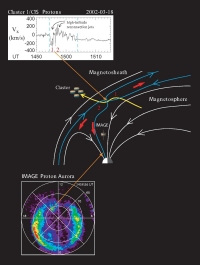ESA PR 31-2003 ESA's Cluster solves auroral puzzle
20 May 2003
ESA's four Cluster spacecraft have made a remarkable set of observations that has led to a breakthrough in understanding the origin of a peculiar and puzzling type of aurora.These aurorae - seen as bright spots in Earth's atmosphere and called dayside proton auroral spots - occur when fractures appear in the Earth's magnetic field, allowing particles given out from the Sun to squirt through and collide with the molecules in our atmosphere. This is the first time that a precise and direct connection between the two events has been made.
The Earth's magnetic field acts like a shield, protecting Earth from the constant stream of tiny particles ejected by the Sun which is known as the solar wind. The solar wind itself is made of hydrogen atoms, broken into their constituent pieces: protons and electrons. When electrons find routes into our atmosphere, they collide with and excite the atoms in the air. When these excited atoms release their energy, it is given out as light, creating the glowing curtains we see as the aurora borealis (or the aurora australis in the southern hemisphere). Dayside proton auroral spots are caused by protons stealing electrons from the atoms in our atmosphere.
 |
|
Illustration of the location of the diffrent spacecraft relative to the Earth and the location of magnetic reconnection on 18 March 2002. |
Philippe Escoubet, ESA's Cluster Project Scientist, comments, "Thanks to Cluster's observations scientists can directly and firmly link for the first time a dayside proton auroral spot and a magnetic reconnection event."
Tai Phan, leading the investigation at the University of California, Berkeley, United States, now looks forward to a new way of studying the Earth's protective shield. He says, "This result has opened up a new area of research. We can now watch dayside proton aurorae and use those observations to know where and how the cracks in the magnetic field are formed and how long the cracks remain open. That makes it a powerful tool to study the entry of the solar wind into the Earth's magnetosphere."
The Earth's interaction with the Sun is a current focus of scientific attention because of its importance in knowing how the Sun affects the Earth, most notably our climate. Also, while not immediately dangerous to us on Earth, it is also important for quantifying the danger to satellites, which can be damaged or destroyed by powerful solar flares.
Note to Editors:
Proton aurorae were globally imaged for the first time by NASA's IMAGE spacecraft. The images revealed the presence of the dayside proton auroral spots. By a fortunate coincidence, IMAGE and Cluster both spotted the event on 18 March 2002. Combining with IMAGE's observations, Cluster made it possible to establish the ground truth of the phenomenon.
The paper on these results, Simultaneous Cluster and IMAGE Observations of Cusp Reconnection and Auroral Spot for Northward IMF by Tai Phan and 24 other authors will be published in Geophysical Research Letters, 21 May 2003, Vol. 30, No. 10.
The principal investigators responsible for the instruments that made these results possible are: Henri Reme of CESR/Toulouse, France (Cluster Proton Detectors), Andre Balogh of Imperial College, London, United Kingdom (Cluster Magnetic Field Instrument) and Stephen Mende of University of California, Berkeley, United States (IMAGE/FUV).
More about Cluster
ESA's Cluster is a collection of four spacecraft, launched on two Russian rockets during the summer of 2000. They are now flying in formation around the Earth, relaying the most detailed information ever in 3D about how the solar wind affects our planet. The solar wind is the perpetual stream of subatomic particles given out by the Sun and it can damage communications satellites and power stations on the Earth. The Cluster mission is expected to continue until at least 2005.
Cluster is part of the International Living with a Star programme (ILWS), in which space agencies worldwide get together to investigate how variations in the Sun affect the environment of Earth and the other planets. In particular, ILWS concentrate on those aspects of the Sun-Earth system that may affect mankind and society. ILWS is a collaborative initiative between Europe, the United States, Russia, Japan and Canada.
For more information, please contact:
ESA Communication Department
Media Relations Office
Paris, France
Tel: +33(0)1 5369 7155
Fax: +33(0)1 5369 7690
Dr Tai Phan
Space Sciences Laboratory
UC Berkeley, United States
Tel: +1 (510) 643 5505
E-mail: phan ssl.berkeley.edu
ssl.berkeley.edu
Dr Philippe Escoubet
ESA Cluster Project Scientist
ESTEC, Noordwijk, The Netherlands
Tel: +31 71 565 3454
E-mail: philippe.escoubet esa.int
esa.int


